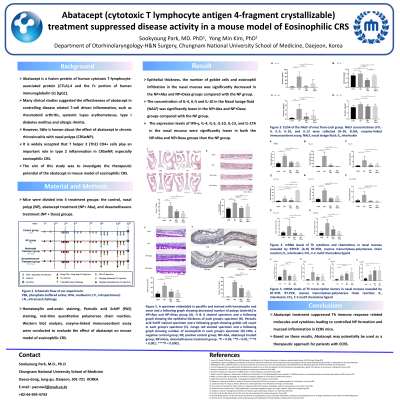Rhinology/Allergy
(1201) Abatacept Treatment Suppressed Disease Activity in a Mouse Model of Eosinophilic Chronic Rhinosinusitis
Monday, September 30, 2024
12:00 PM - 1:00 PM EDT

Has Audio
Disclosure(s):
SOOKYOUNG PARK, MD: No relevant relationships to disclose.
Introduction: Abatacept is a fusion protein of human cytotoxic T-lymphocyte-associated protein (CTLA)-4 and the Fc portion of human immunoglobulin G1 (IgG1). Abatacept is increasingly used for inflammatory disease including rheumatoid arthritis (RA). However, little is known about the effect of abatacept in chronic rhinosinusitis with nasal polyps (CRSwNP). The aim of this study was to investigate the therapeutic potential of the abatacept in mouse model of eosinophilic CRS.
Methods: Mice were divided into 4 treatment groups: the control, nasal polyp (NP), abatacept treatment (NP+ Aba), and dexamethasone treatment (NP + Dexa) groups. Hematoxylinand-eosin staining, Periodic acid Schiff (PAS) staining, real-time quantitative polymerase chain reaction, Western blot analysis, enzyme-linked immunosorbent assay were conducted to evaluate the effect of abatacept on mouse model of eosinophilic CRS.
Results: Epithelial thickness, the number of goblet cells and eosinophil infiltration in the nasal mucosa was significantly decreased in the NP+Aba and NP+Dexa groups compared with the NP group. The concentration of IL-4, IL-5 and IL-10 in the nasal lavage fluid (NLF) was significantly lower in the NP+Aba and NP+Dexa groups compared with the NP group. The expression levels of IFN-γ, IL-4, IL-5, IL-10, IL-13, and IL-17A in the nasal mucosa were significantly lower in both the NP+Aba and NP+Dexa groups than the NP group.
Conclusions: Abatacept treatment suppressed Th immune response related molecules and cytokines as well as controlling NP formation and mucosal inflammation in ECRS mice. Based on these results, Abatacept may potentially be used as a therapeutic approach for patients with ECRS

Sookyoung Park, MD
Assistant Professor
Chungnam National University Sejong Hospital
Sejong, Ch'ungch'ong-namdo, Republic of Korea
